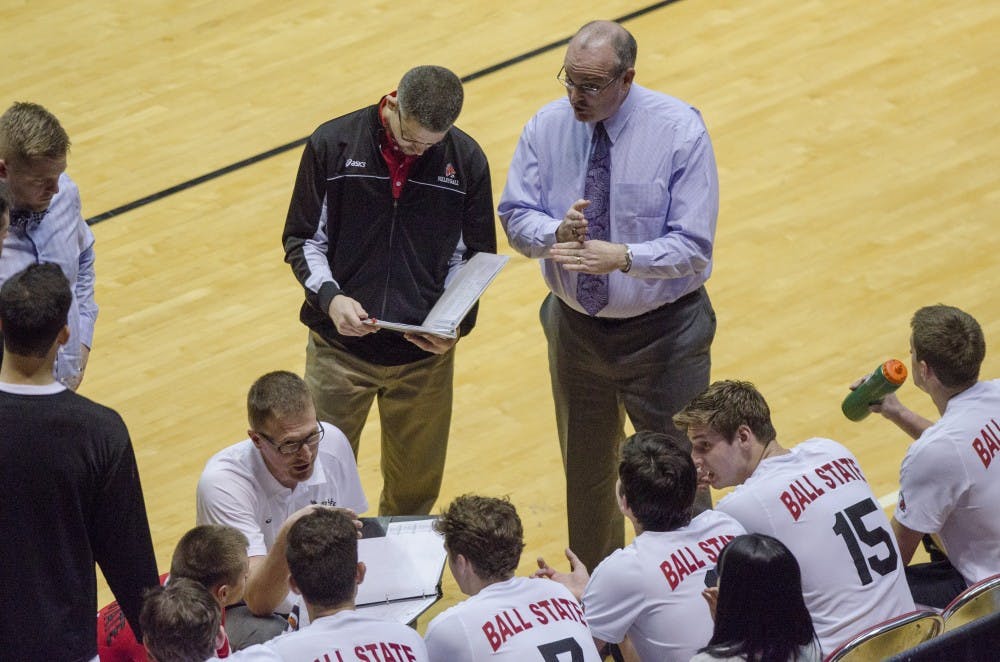Ball State
Athletics
Only certain sports are “head-count” sports, which means the number of scholarships given out must equal the number of players on scholarship. The rest of the sports are “equivalency” sports, which means the team has a certain amount of scholarships to be given out to as many players as the team sees fit. The following numbers are from the 2014-15 seasons.
NCAA Permits /
Currently Awarded
EQUIVALENCY
sports
Baseball
11.70/11.70
Field hockey
12.00/11.57
Men’s golf
4.50/4.11
Women’s golf
6.00/6.00
Soccer
14.00/11.68
Softball
12.00/10.57
Men’s swimming
9.90/0.06
Women’s swimming
14.00/10.75
Men’s tennis
4.50/4.47
Track
18.00/17.60
Men’s volleyball
4.50/4.40
Head-count
scholarships
Women’s tennis
8.00/7.00
Women’s volleyball
12.00/12.00
Gymnastics
12.00/12.00
Football
85.00/85.00
Women’s basketball
15.00/13.00
Men’s basketball
13.00/12.00
Note: Information accurate as of 10/8/2014.
SOURCE: Ball State Athletics, cbsnews.com
Editor's Note: In Thursday's print issue, the information under "Median Values" on page one is total generated revenues and expenses by the collective Division I - FBS schools in 2013, not the Ball State men's volleyball team alone. Division I - FBS men's volleyball programs lost a total of about $352,000 in 2013, rather than per school, which was stated in the story. As a whole, the story is looking at the future of NCAA men's volleyball, not just Ball State's.
About 10 years ago, Ball State men's volleyball coach Joel Walton sat in front of the Ball State administration to discuss keeping the program alive at the school.
This was the third time in his career he was forced to discuss why men's volleyball made sense for the future of the university, and why it shouldn't drop the team completely.
"In the collegiate athletic realm, we've spent a lot of time catching up," Walton said. "Even though there are more boys playing, getting Division I schools excited or even willing to add men's volleyball has been extremely difficult."
The University of Pacific cut its program after the 2014 season in accordance to its "Focusing on our Future" campaign. Following the cut, former Pacific player Edgardo Cartagena is now playing for Ball State.
While Ball State isn't in immediate danger of losing its team, universities have dropped their programs due to an overall lack of interest and negative net revenue numbers.
According to the NCAA Sports Sponsorship and Participation Rates Report 2013-2014, Division I men's volleyball had 33 teams in the 1981-82 season, and experienced a large drop that reached as low as 20 teams from 1986-88.
In 2015, there are 28 Division I men's volleyball programs left. However, the combination of Division I and Division II creates a larger competition field.
From slow beginnings, men's volleyball never had a chance to explode prior to the gender equity laws formed in 1972. School administration did not find it necessary to add men's volleyball as a sport.
The NCAA was officially founded in 1906, but men's volleyball did not have a registered collegiate championship until 1970.
Walton said these humble beginnings are the reason that men's volleyball still doesn't have a huge following.
Ball State has an attendance average of 934 per home match this season. The university does not charge students or adults to attend men's volleyball matches and relies primarily on donations to cover general costs, equipment and travel among other expenses.
According to the NCAA Revenues/Expenses Division I Report from 2004-2013, Division I men's volleyball lost about $352,000 in 2013.
But Walton said there is an overlook when it comes to the revenue numbers brought in by sports teams, and the distinction between which sports bring in revenue.
"When you look at collegiate athletic programs, there's a misnomer in revenue sports and non-revenue sports," he said. "I think men's volleyball makes a lot of sense. We only have four-and-a-half scholarships, so the other 15 of our guys are paying full price to be here."
Since about 75 percent of a team's roster pays full tuition to their respected universities, total revenue gained through tuition exceeds the expenses for the sport.
While men's volleyball is on the decline, women's volleyball has added over 100 teams in the past 32 years. Women's volleyball has more than three times the number of men's volleyball programs across all three NCAA divisions.
Title IX requires gender equity for men's and women's athletics in every educational program that receives federal funding. This forces school administration to balance the number of sports teams on both ends of the gender spectrum.
But when school administrations sit down to discuss funding for athletic teams, revenue sports like football and basketball are almost always safe for the future. Men's volleyball and other small sports are sometimes categorized as a flexible option.
Ball State's rich history of volleyball works in its favor, as it helped start men's volleyball across the country. The program benefits from continuing contributions of longstanding fans and alumni.
While the sport does not sell tickets like football or basketball, men's volleyball is seen as successful rather than a risk at varying schools across the nation. The sport can also draw a big crowd if a top team comes to town — Ball State drew 1,513 spectators when then No. 10 Penn State came to Worthen Arena on Jan. 16.





